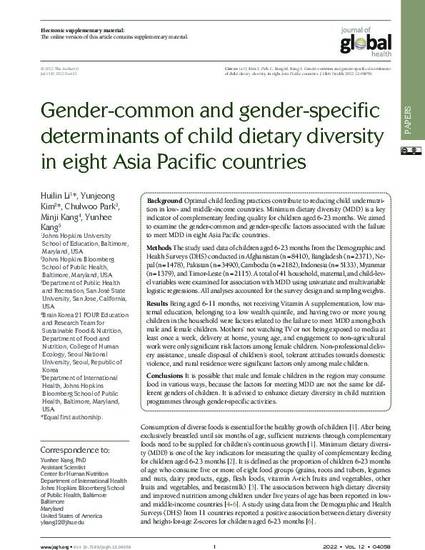
Background
Optimal child feeding practices contribute to reducing child undernutrition in low- and middle-income countries. Minimum dietary diversity (MDD) is a key indicator of complementary feeding quality for children aged 6-23 months. We aimed to examine the gender-common and gender-specific factors associated with the failure to meet MDD in eight Asia Pacific countries.
Methods
The study used data of children aged 6-23 months from the Demographic and Health Surveys (DHS) conducted in Afghanistan (n = 8410), Bangladesh (n = 2371), Nepal (n = 1478), Pakistan (n = 3490), Cambodia (n = 2182), Indonesia (n = 5133), Myanmar (n = 1379), and Timor-Leste (n = 2115). A total of 41 household, maternal, and child-level variables were examined for association with MDD using univariate and multivariable logistic regressions. All analyses accounted for the survey design and sampling weights.
Results
Being aged 6-11 months, not receiving Vitamin A supplementation, low maternal education, belonging to a low wealth quintile, and having two or more young children in the household were factors related to the failure to meet MDD among both male and female children. Mothers’ not watching TV or not being exposed to media at least once a week, delivery at home, young age, and engagement to non-agricultural work were only significant risk factors among female children. Non-professional delivery assistance, unsafe disposal of children’s stool, tolerant attitudes towards domestic violence, and rural residence were significant factors only among male children.
Conclusions
It is possible that male and female children in the region may consume food in various ways, because the factors for meeting MDD are not the same for different genders of children. It is advised to enhance dietary diversity in child nutrition programmes through gender-specific activities.
Available at: http://works.bepress.com/chulwoo-charles-park/34/
